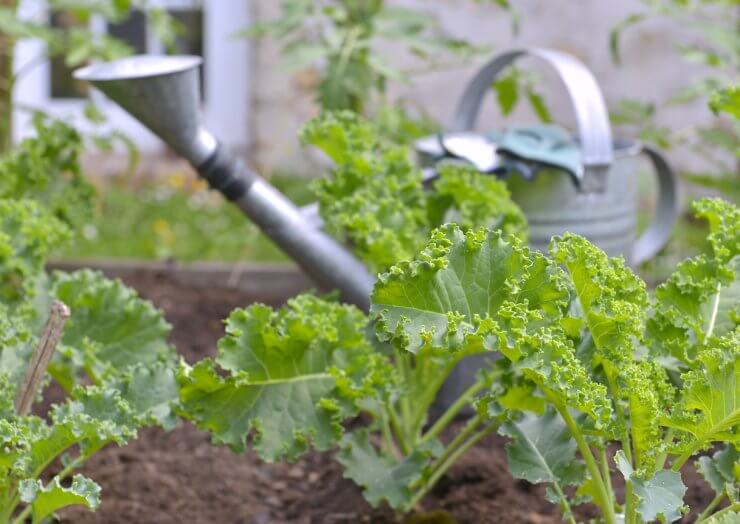
Watering can next to kale in the garden
Water
Once your kale is settled in—whether it’s in a container, a raised bed, or open ground—consistency is key when it comes to watering. If you don’t get rain on a regular basis, go out and give your kale a good drink of water. Kale likes soil that’s moist, but not soggy.
In general, you’ll want to water deeply about once a week. If the top of the soil is a little dry, that’s OK. But don’t let the soil dry out. This is especially important when you’re tending growing in containers—their roots can only reach so far in search of more water. Kale that gets stressed because it’s not getting enough water will turn bitter. Literally.
For plants in the ground, make sure the ground gets a good soaking. If you have sandy soil, plan to water more often than just once a week. Check the moisture level of your soil by sticking a gardening trowel into the soil next to the plant. If the soil is only moist to a level of an inch or two, your plants are in need of a good watering.
It’s best to water in the morning, so any excess water on the leaves can evaporate. That will help keep your leaves fresh and less likely to develop a fungal infection.
Weeding
When it comes to weeding around your kale, frequent, shallow cultivation is the way to go. You want to get to weeds before they become a problem. Cultivate the soil just enough to cut the weeds off below the soil line. Always be careful that you’re just getting the weeds, and not your kale plants.
Mulching can also help deter weeds. Consider untreated grass clippings, clean straw that’s free of weeds or seeds, or well-rotted compost. Lay down a layer 3 to 4 inches deep. Not only will that help deter weeds, it will also help the soil retain moisture.
Another mulch you can consider is nitrogen-fixing clover. Since kale loves nitrogen to grow its leaves, clover can provide an ongoing supply.
Fertilizer
Since kale is a heavy feeder, it’s a good idea to give your kale plants a little side dressing of fertilizer about once every four weeks. Choose a vegetable fertilizer that’s high in nitrogen. If you have well-rotted compost, that can be helpful as well. And if you’ve rotated your kale crop into an area where nitrogen-fixing plants grew in the previous season, you should see your plants flourish.
How often do you have to fertilize or water your kale? Do you have any particular challenges growing kale? Please tell us your tips for growing productive kale.


 Previous
Previous

